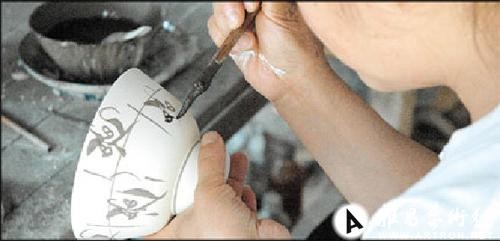
One day in Jingdezhen: China's porcelain hub
2011-07-04 14:42:02 未知

One of the masters at the Ancient Kiln Exhibition Center in Jingdezhen paints the design onto a bowl before it's glazed. When the bowl is fired, the black ink will turn blue. (Source: ShanghaiDaily.com/Laura Imkamp)
It's 9am on a sunny spring morning in Jingdezhen and I'm getting off a plane from Shanghai with eight other women. They're all there for one thing: porcelain.
Jingdezhen in Jiangxi Province has been China's porcelain capital for about 1,800 years and as we ride into town from the airport, the signs are everywhere: giant vases, billboards advertising porcelain shops; even the lampposts are decorated in porcelain.
It's a unique heritage and an important one in Chinese history. The porcelain from Jingdezhen is said to be "as thin as paper, as white as jade, as bright as a mirror, sounding as clear as a chime."
The words "porcelain" and "china" are basically synonymous, thanks in large part to this town, where the emperor Jingde (968-1022) laid the groundwork for top-quality ceramics during the Song Dynasty (960-1279).
In fact, Jingdezhen native Natalie Wu, 29, says this may even be where the country's English name "China" comes from. The city was once named Changnanzhen, which, according to local legend, was difficult for foreign traders to pronounce. They shortened "Changnan" to "China," and, somehow, that stuck.
Eventually the emperor renamed the town Jingdezhen, after himself, to solidify his role in developing the porcelain trade. The city is still one of the world's porcelain hubs today, but as we make our way to one of the porcelain markets, there's not much in the way of scenery.
Indeed, most of the tourism here is somehow connected with the main industry rather than sightseeing.
Case in point: the women I'm with are here for today only, to buy porcelain at a fraction of what it would cost in Shanghai.
It's still fairly early when we get to the International Trade Square market, and since I'm not here just to shop, Wu - a part-time tour guide and part-time antique pottery student - and I head over to the Ancient Kiln Folk Exhibition Center. It's almost like an assembly line here. Everything is hand-made by retired ceramics masters, each specializing in a particular step.
The first master shapes the bowls; the second trims and reshapes them; the third applies a layer of glaze; the fourth paints, and so on through every step of the process from the initial shaping to the final firing.
Plaques of achievement hang above the work stations; many of the old pros have focused on this one specific skill since childhood.
Wang Yansheng, for example, is trained to the core for one of the very first steps: creating the shape.
"I like making the body," the 73-year-old says. "In my whole life that's all I've learned, all I did."
He has been doing this since he was eight years old.
These items are only available at this exhibition and range in price from 80 yuan (US$10.30) for a simple bowl to around 2,600 yuan for a large, multi-tiered vase.
While this isn't outrageously expensive considering the pieces are handmade in-house, the markets tend to be a good deal cheaper and you can bargain. As we head back, Wu tells me the International Trade Square is one of the cheapest markets, but that comes at the cost of quality.
In fact, Wu says a lot of the porcelain sold here isn't even from Jingdezhen - but the shopkeepers won't always tell you that.
To make a bigger profit, vendors buy mass-produced clay bodies from other provinces such as Guangdong and paint or stick decals on them.
"Instead of making them by hand, all of those products are machine-made," she says. "So it's cheaper and faster, but the quality is not as good (as Jingdezhen porcelain)."
One giveaway is easy to spot: if a few of the same items have the exact same design, chances are the decoration has been stenciled on.
Another rule of thumb: the whiter the porcelain, the better.
But a key way to tell real Jingdezhen porcelain is its hardness, and that's a little more difficult for the untrained shopper to distinguish.
Jingdezhen native Jiang Meirong, 72, owns a stall at this market and insists she only sells Jingdezhen porcelain because "other cities use lower firing temperatures so the porcelain breaks more easily."
"It's harder in Jingdezhen. And the clay is better here."
But that's not to say all of Jingdezhen's sidewalks are overflowing with copies. Many of the smaller shops sell more unique, original pieces.
Of course, those tend to come at a higher price, so where you shop comes down to whether you're more concerned with quality or cost.
For the women I'm with, it's a bit of both. And as the sun dips lower in the sky, they trickle back toward the growing pile of porcelain in all shapes and sizes, pleased with the deals they got.
This is, after all, a porcelain shopper's paradise.
(责任编辑:张天宇)
注:本站上发表的所有内容,均为原作者的观点,不代表雅昌艺术网的立场,也不代表雅昌艺术网的价值判断。
 阿拉里奥画廊上海转型:为何要成为策展式艺术商业综合体?
阿拉里奥画廊上海转型:为何要成为策展式艺术商业综合体? 李铁夫冯钢百领衔 作为群体的早期粤籍留美艺术家
李铁夫冯钢百领衔 作为群体的早期粤籍留美艺术家 “纤维”提问2022:存在何“缓”?
“纤维”提问2022:存在何“缓”? 徐冰:地球上不能解决的艺术问题,去外太空换个新角度
徐冰:地球上不能解决的艺术问题,去外太空换个新角度
全部评论 (0)